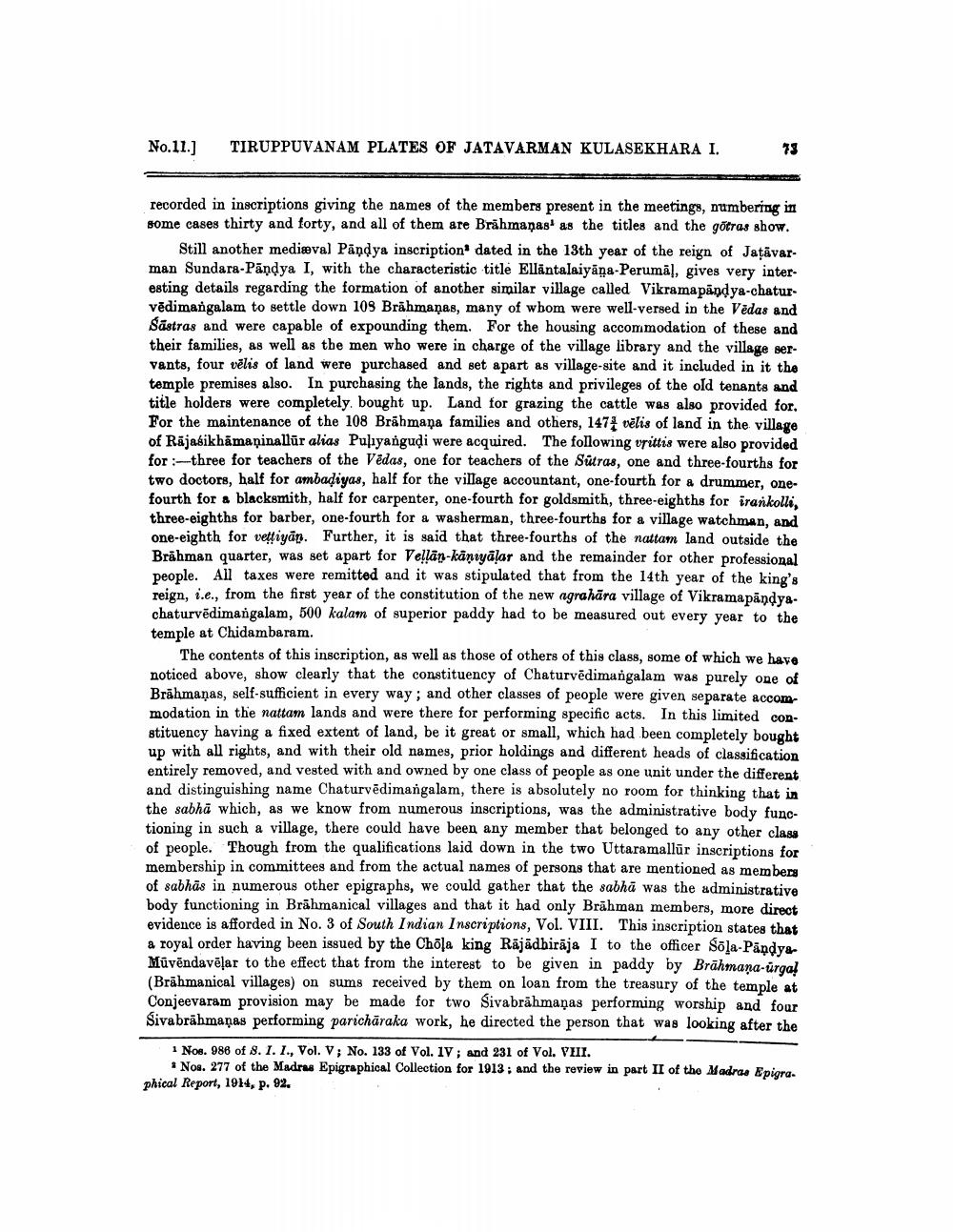________________
No.11.)
TIRUPPUVANAM PLATES OF JATAVARMAN KULASEKHARA I.
recorded in inscriptions giving the names of the members present in the meetings, numbering in some cases thirty and forty, and all of them are Brahmaṇast as the titles and the gotras show.
Still another medieval Pandya inscription dated in the 13th year of the reign of Jaţāvarman Sundara-Pandya I, with the characteristic title Ellántalaiyāna-Perumā], gives very interesting details regarding the formation of another similar village called Vikramapandya-chaturvēdimangalam to settle down 109 Brāhmaṇas, many of whom were well-versed in the Vedas and Sāstras and were capable of expounding them. For the housing accommodation of these and their families, 88 well as the men who were in charge of the village library and the village servants, four vēlis of land were purchased and set apart as village-site and it included in it the temple premises also. In purchasing the lands, the rights and privileges of the old tenants and title holders were completely bought up. Land for grazing the cattle was also provided for. For the maintenance of the 108 Brāhmaṇa families and others, 1474 vēlis of land in the village of Rajasikhamaninallur alias Puliyangudi were acquired. The following usittis were also provided for :-three for teachers of the Vedas, one for teachers of the Sutras, one and three-fourths for two doctors, half for ambadiyas, half for the village accountant, one-fourth for a drummer, onefourth for a blacksmith, half for carpenter, one-fourth for goldsmith, three-eighths for irankolli, three-eighths for barber, one-fourth for a washerman, three-fourths for a village watchman, and one-eighth for vettiyān. Further, it is said that three-fourths of the nattam land outside the Brahman quarter, was set apart for Vellän-kanryalar and the remainder for other professional people. All taxes were remitted and it was stipulated that from the 14th year of the king's reign, i.e., from the first year of the constitution of the new agrahāra village of Vikramapāndya. chaturvēdimangalam, 500 kalam of superior paddy had to be measured out every year to the temple at Chidambaram.
The contents of this inscription, as well as those of others of this class, some of which we have noticed above, show clearly that the constituency of Chaturvēdimangalam was purely one of Brāhmaṇas, self-sufficient in every way; and other classes of people were given separate accommodation in the nattam lands and were there for performing specific acts. In this limited constituency having a fixed extent of land, be it great or small, which had been completely bought up with all rights, and with their old names, prior holdings and different heads of classification entirely removed, and vested with and owned by one class of people as one unit under the different and distinguishing name Chaturvēdimangalam, there is absolutely no room for thinking that in the sabhā which, as we know from numerous inscriptions, was the administrative body functioning in such a village, there could have been any member that belonged to any other class of people. Though from the qualifications laid down in the two Uttaramallūr inscriptions for membership in committees and from the actual names of persons that are mentioned as members of sabhās in numerous other epigraphs, we could gather that the sabhā was the administrative body functioning in Brāhmanical villages and that it had only Brahman members, more direct evidence is afforded in No. 3 of South Indian Inscriptions, Vol. VIII. This inscription states that & royal order having been issued by the Chola king Räjädbirāja I to the officer Sola-PandyeMūvēndavēlar to the effect that from the interest to be given in paddy by Brāhmaṇa-urga! (Brāhmanical villages) on sums received by them on loan from the treasury of the temple at Conjeevaram provision may be made for two Sivabrāhmaṇas performing worship and four Sivabrāhmaṇas performing parichāraka work, he directed the person that was looking after the
Nos. 986 of 8. I. I., Vol. V; No. 133 of Vol. 1V ; and 231 of Vol. VIII.
* Nos. 277 of the Madrus Epigraphioal Collection for 1913, and the review in part II of the Madras Epigra. phical Report, 1914, p. 92.




